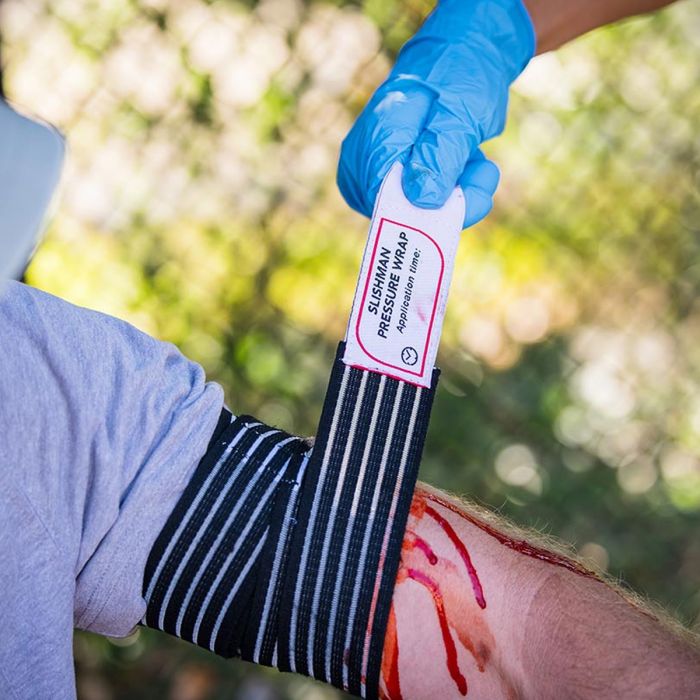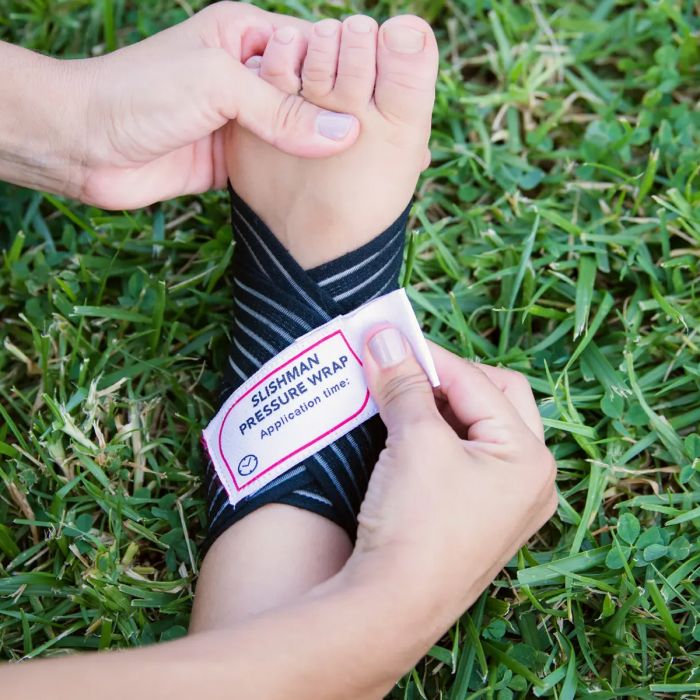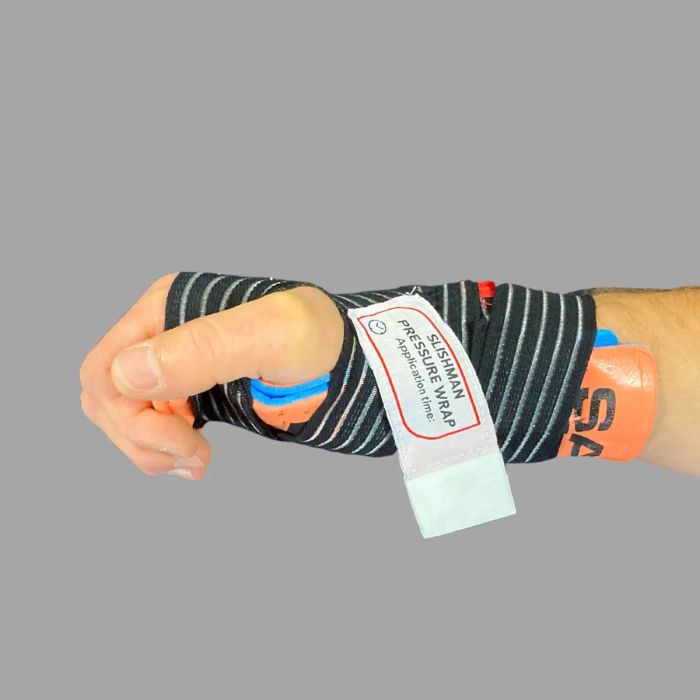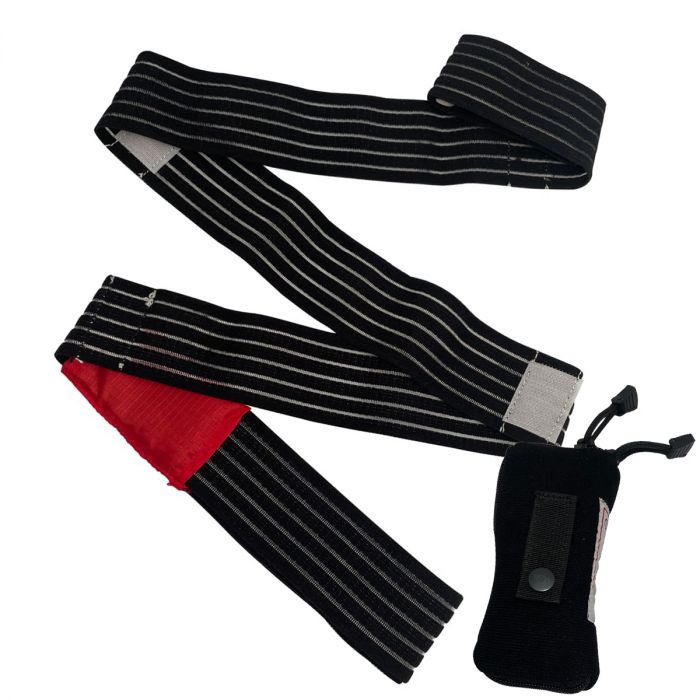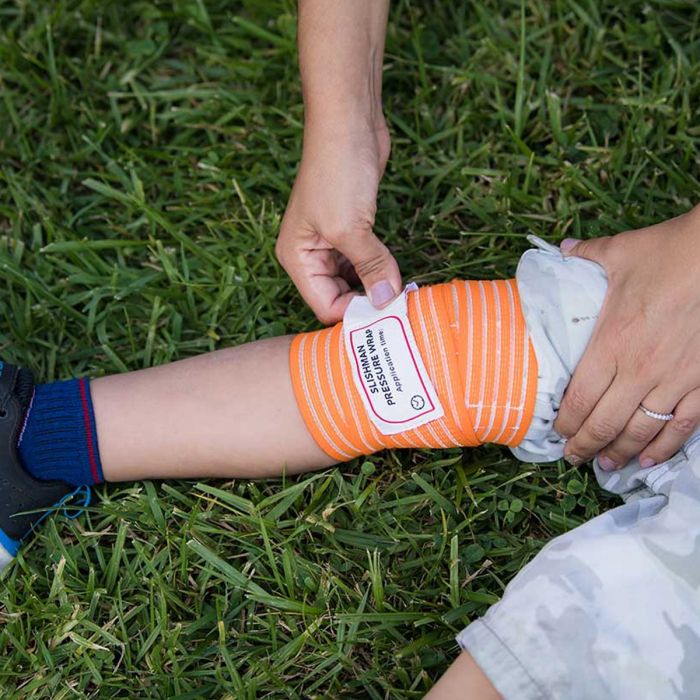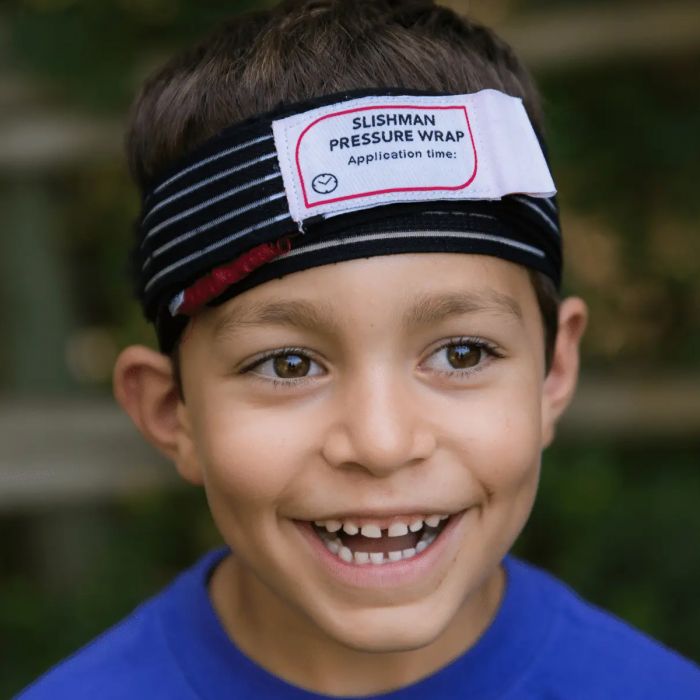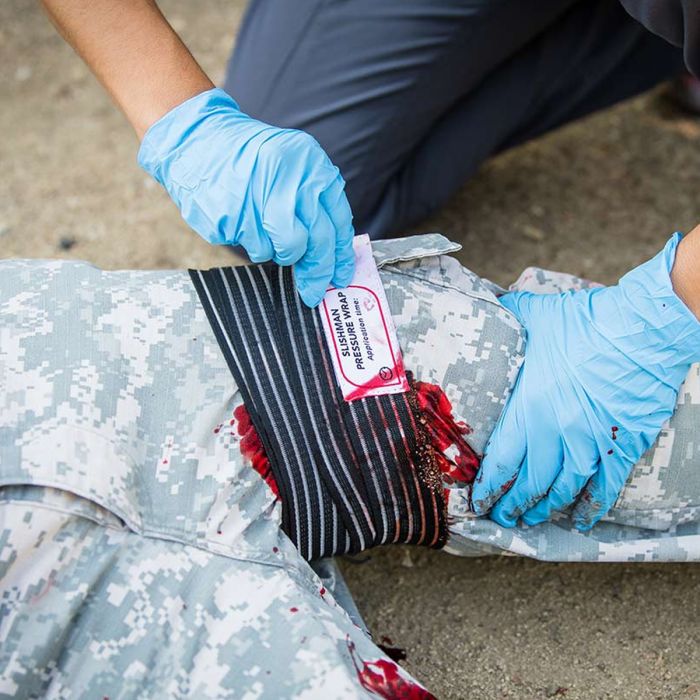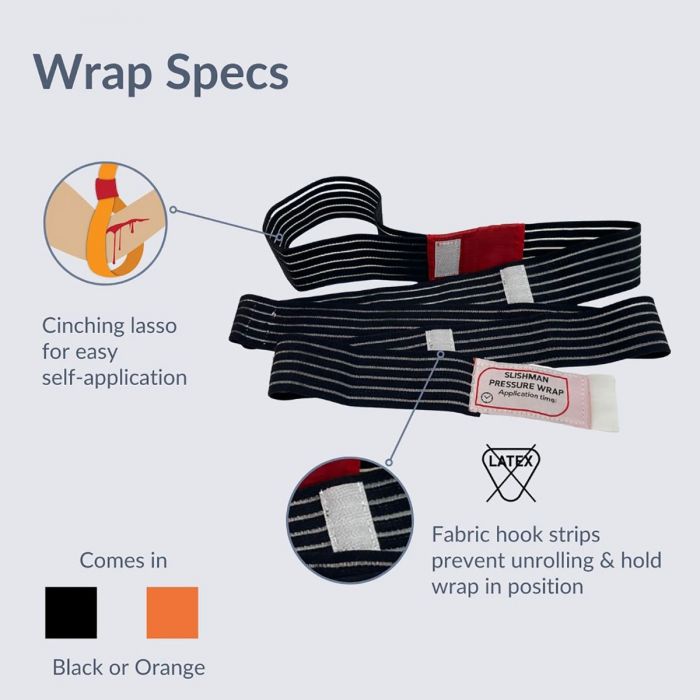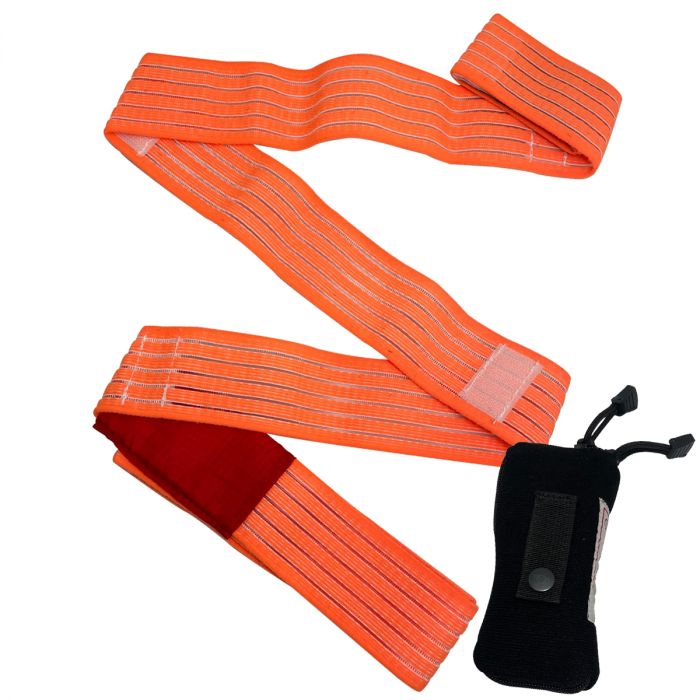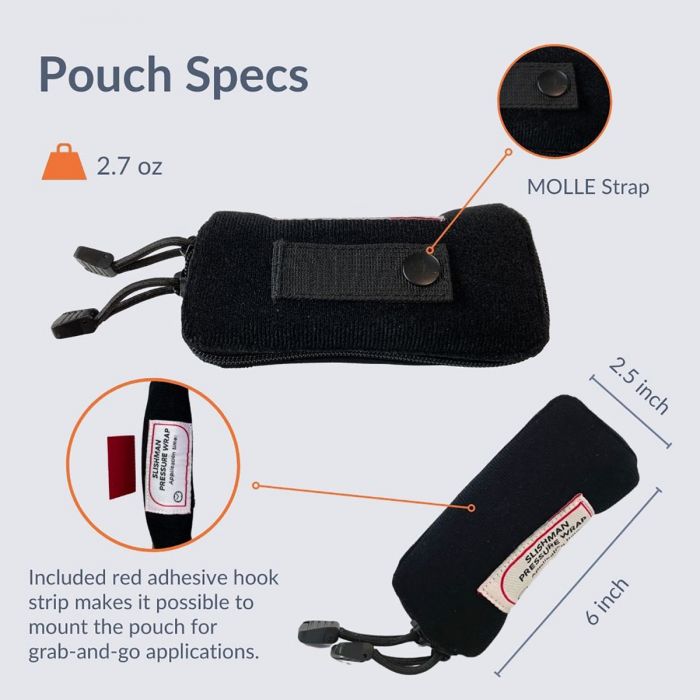Slishman Pressure Wrap (with Pouch)
Earn 74 Points when you buy this item.
Couldn't load pickup availability
Description
Description
More than bleeding control
The Slishman Pressure Wrap with pouch (SPW) is an extremely versatile tool that should be in any IFAK, go-bag, or larger first aid kit and is useful in a wide range of environments, including tactical, civilian, marine and veterinary. The lightweight black or orange elastic wrap includes a red slip sleeve forming a lasso that is easy to cinch and allows for application around an injured limb. Compact and conforming, the SPW is easy-to-use and designed primarily as a pressure dressing but can be used as an initial tool for bleeding control, to protect wounds, stabilise extremities or to hold splints in place.
This item is a Slishman Pressure Wrap with MOLLE compatible pouch. Click here to view without pouch.
The included black neoprene pouch holds a wrap and allows space for other items such as plasters, gauze, medications, gloves, etc. The pouch has a double-pull zipper for easy access and a MOLLE strap on one side for strapping to a belt or outside of a pack. Also included is an adhesive Velcro strip to make it easy to mount the pouch in public areas (on AED boxes, refrigerators, cabinets, or other flat surfaces) making the wrap easy to grab-and-go.
A multitool for your every day carry (EDC)
- Less tissue damage - Soft, wide and finely adjustable.
- One size fits all - Fits adults, children, and even pets.
- Intuitive - Easy to apply for seasoned medics and untrained first responders.
- Packable - Light, compact and flexible.
- Durable - Works even when wet or soiled.
- Multi-Use - Good for bleeding, sprains and contusions. Many non-medical uses as well.
- Self Application - Easy self-application with minimal fine motor dexterity required.
Dimensions: 10.2 x 4 x 2.5cm
Weight: 34g (wrap only), 77g (wrap + pouch)
Slishman Pressure Wrap Instructions
Victims are always their closest first responders so easy self-application is critical. The Slishman Pressure Wrap is extremely easy to apply using the following steps:
- Loop over injured limb & apply to injury (or simply wrap for entrapped limb)
- Cinch the red sleeve until snug
- Use a wide wrap for long lacerations, or a narrow, tight wrap for more severe bleeding (between the injury and heart)
- Wrap the elastic all the way to the white label, then secure hooks to the elastic
- Note application time on the white label
- Adjust for pain minimisation, while monitoring bleeding, pulses, sensation and motor function
- Leave in place until definitive wound management can be accomplished ASAP
NOTE: Do not encircle and tighten around the neck.
Dr Slishman's perspectives on bleeding, bleeding control devices, and the Slishman Pressure Wrap
After many wars, and plenty of mass shootings, one of the few silver linings is that we have learned some things about helping injured people to survive. When I started my emergency medicine residency, the ABCs (airway, breathing, circulation) were never questioned. Now we acknowledge that aerating blood free lungs is pointless.
The acronym “MARCH” stands for Massive hemorrhage, Airway, Respiration, Circulation, Hypothermia and is being used more and more frequently nowadays, with heavy emphasis placed on the “M”. If massive hemorrhage isn’t addressed quickly, it’s hard moving to “A.” The emphasis on rapid bleeding control has led to development of a wide variety of devices, hemostatic agents, infusions and techniques, along with numerous simulation devices and “Stop-the-Bleed” trainings.
When considering which of these innovations to adopt, it is useful to consider vantage points. If you are a general watching from your horse on a hilltop, a medic saving lives under fire, a foot solider on the frontlines, a civilian police officer, a teacher or a student in a classroom, your calamity preparation choices may differ. Costs and opportunity costs, along with probabilities Vs. possibilities should be considered. The best ways to stop bleeding in civilian settings like malls, schools or airports may differ from those used on battlefields.
Who may benefit most?
The untrained. No matter how much effort is put into public awareness and training to stop bleeding, it is often terrified, untrained, first responders who are first on scene; especially in civilian settings. Trained or untrained first responders, or victims themselves, shouldn’t have to differentiate between arterial Vs. venous bleeding. And hours of training shouldn’t be required for use. Simplicity is critical. The Slishman Pressure Wrap is easy to apply by seasoned professionals, untrained civilians and even children.
What works best to stop bleeding and what is least likely to cause harm?
Well-aimed direct pressure. Most (if not all) bleeding, whether venous river, capillary ooze or arterial geyser needs direct pressure, and frequently nothing more. Immediate direct pressure and wrapping are instinctual. It is hard to make someone who is bleeding any worse with immediate direct pressure. Even if there may be ongoing ooze through the wrap, that is still better than an open wound, as well as a poorly applied tourniquet.
What improves likelihood for a bleeding control device to be used and to actually be useful?
Survival improves the faster bleeding control devices are used after bleeding begins. Therefore, easy self-application is critical, because victims are always the closest first responders to themselves. As product weight, size, packability, complexity, and cost go down, likelihood for EDC (every day carry) and proximity to bleeding goes up. Multi-utility also improves likelihood for EDC and proximity to injuries. The Slishman Pressure Wrap weights 1.2 ounces and 2.7 in its pouch. It is 1.6” x 4” x 1”, is very flexible and can be greatly compressed. And there are numerous medical and non-medical uses for the product that are completely unrelated to bleeding.
What's the right amount of pressure to control bleeding?
The optimal pressure for bleeding control is when bleeding stops, and nothing more. Any additional pressure above and beyond hemostasis increases pain and tissue damage unnecessarily. While rapid hemostasis is the highest priority for saving a life, comfort matters and is directly related to morbidity and long-term pain/disability. The hooks under the label of the wrap allow essentially infinite adjustability, so the process of application as well as removal can be finely tuned.
What should happen following haemostasis?
Patient care does not stop when bleeding stops. Following hemostasis, vasospasm and clotting reduce the pressure required. Pain associated with limb ischemia as well as skin pinch should be considered, rather than ignored and handed off to future caregivers. Fine adjustability of the Slishman Pressure Wrap can minimize pain and tissue damage, and can facilitate gentle and controlled eventual removal.
What about children, pets or larger limbs?
First responders shouldn’t have to choose between small, medium and large. One size should fit all … babies, cats, dogs, and rhinos included. And even if your rhino keeps bleeding, direct pressure will still help. No limb is too small for the Slishman Pressure Wrap. Fully stretched, it reaches 10 feet, so even for larger limbs, one size fits darn near all… and a second placed on top of the first will cover the rest.
What if the device is damaged?
While it makes sense for bleeding control devices to be single use when bloodied, users shouldn’t fear damaging their preferred devices with a bit of practice. Damage should not render a device useless either. The Slishman Pressure Wrap works under water, in snow, sand and mud, and will still work even if the elastic is torn half way through. Even with prolonged sun exposure and lost elasticity, direct pressure will still be possible. No need to fear sudden catastrophic failure with malfunction, as is the case for many bleeding control devices.
What other factors should be considered and what else may hinder proper application?
Fine motor dexterity should not be required for use of any bleeding control device. Plastic wrappers slow application. And lengthy written instructions are unlikely to be read, while potentially slowing treatment. Use should be inherently obvious. No need to tear wrappers or twist or even read instructions to use the Slishman Pressure Wrap. Just loop, pull, wrap, assess and reassess.
What's better in first aid; specific or general use items?
General. Any device that offers multiple medical and non-medical uses is preferable. Use the Slishman Pressure Wrap to splint fractures or sprains. Wrap around damaged boot buckles to hold them in place. Wrap around limbs to further protect from the cold. Wrap loosely over soaked gauze to comfort burns. Hold SAM Splints in place. Tie skis together. Use as a leash for dogs, cats or even as a surf leash. The list of alternative uses is enormous.
Why not use the word "tourniquet"?
For one, a “wrap” is less of a barrier to use. Because of protocols stating “tourniquets should be left in place until received by facilities equipped to care for trauma”, by avoiding the word, first responders may be less anxious to use the product. Simply wrap to hemostasis, then back off for pain control. The word “wrap” under promises and over delivers.
Specifications
Specifications
Delivery & Returns
Delivery & Returns
Free UK Tracked Delivery on orders over £25 + VAT
For full information refer to our Delivery Information page
Returns:
Please use our Returns Portal to request your return and choose your method of resolution.
For full information refer to our Return Policy
